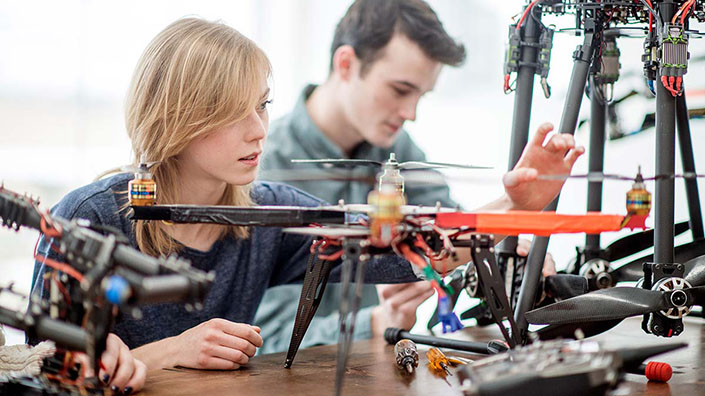Engineers are building, shaping, crafting the future – but they are already “a different breed of people than the engineers we educated in the 20th century”.
That’s James Plummer’s opinion, anyway. And Plummer should know what he’s talking about – he’s an engineering professor and former dean at Stanford University, California. “I used to tell students it doesn’t matter what we teach you because it will be obsolete when you graduate, so go out and have a good time,” he said at a recent engineering summit in San Francisco. With increasing automation, he added, education must focus on producing engineers who do what computers can’t. And on keeping students interested and engaged for the whole degree course – which isn’t easy.
“We send new undergraduates off to take maths and science and tell them to come back if they survive, so dropout rates are 50% or more,” said Plummer. “This kind of education, which shuts out opportunities to explore the liberal arts, is structured so that most students say, ‘Why do that when I can do more interesting things in life?’.” So they leave. Or they leave after they get a diploma.
C for 'creativity'
In the UK, fewer than half of all engineering students become professional engineers after earning their degrees, according to last year’s Royal Academy of Engineering report.
So there’s a dearth of suitable job candidates. Universities, meanwhile, often lack forward-looking degree programmes, while their training is less and less relevant as product cycles shorten. Little wonder that ever more people argue for a radical shift in engineering education, towards more interdisciplinary qualifications and clearer, more consistent roadmaps for apprenticeships.
In the UK alone, estimates suggest that 1.8 million new engineers and technicians are needed by 2025, but a recent report from the Pew Research Centre predicts that education programmes are incapable of making adjustments within the next decade to meet the needs of job markets.
 A group of students working on building a machine with drone parts (Credit: iStock)
A group of students working on building a machine with drone parts (Credit: iStock)
Getting the training right, however, is anything but straightforward. Technologies – and therefore skills needs – are evolving fast; politicians are rarely focused on constantly updating the required educational infrastructure; and teaching ‘soft skills’ – such as creativity, analytical thinking, multitasking, communication and adaptability – is not that easy. To meet these challenges requires a shake-up of traditional education models, may require the development of new qualifications, and will force students, teachers and employers to discard entrenched attitudes to learning.
Plummer says undergraduate engineering courses should be broadened to include liberal arts and life skills, so that students are better prepared for the unpredictable careers the future will throw at them. He believes graduates will be best served by acquiring better communication skills, the ability to work in teams, gaining global knowledge and having an entrepreneurial outlook.
It’s a view shared by Institution of Engineering and Technology president Jeremy Watson, who is in favour of more focus on creativity and problem-solving. And slowly, throughout the world, more and more educators are beginning to experiment with new approaches to the way engineering is taught.
Britain’s first purpose-built university in 40 years, the New Model in Technology & Engineering, is due to open its doors in Hereford in September 2019. It has high ambitions: to be the UK’s innovation lab for changing engineering education.
With £8 million in start-up funding from the government (state support will ultimately provide about a third of the £73 million project cost) and an additional £1 million raised from the local community, it promises a curriculum that combines the best innovation from around the world. The new university is aiming for an intake of 5,000 students, with a 50:50 gender balance, by 2032.
Its president and chief executive, Polish-born Canadian Janusz Kozinski, is the founding dean of the pioneering Lassonde School of Engineering in Toronto, Canada. He believes that, instead of an archaic educational approach based on the opportunities we had in the 1950s and 60s, we need to use real-world problem-solving, blended with high-quality engineering, design, liberal arts and humanities, communication and employability skills. These are the qualities engineers will need to meet the demands of employers going through what’s often called the fourth industrial revolution.
“We will have zero lecture halls, no exams, and students will no longer take parallel courses in subjects such as thermodynamics, chemistry and physics,” says Kozinski. “Instead, they will focus on practical problems brought to us by our industry colleagues and will work on one project at a time – 15 projects in total over the course of three years. This will form the basis of their assessment and lead to a portfolio of work. The focus will be on learning rather than teaching.”
Opportunities to explore
Each project the students can expect to work on will have a strong social value, Kozinski explains. Examples might include helping Heineken to develop filtering systems to produce purer cider; assisting another project partner, Cargill, to develop a more effective production line to deliver feedstock to birds; and developing systems to minimise the fuel used by vehicles when navigating city streets or the energy used to light them.
Kozinski was recently involved in developing a ground-breaking Canadian project that will give engineering students a whole city to experiment on. Later this year, Oshawa, Ontario will become Canada’s first living laboratory for urban research, allowing students to probe complex municipal issues and test practical solutions for the future.
Other places are ready to embrace new technology, too. London South Bank University, for instance, has started using 3D models and virtual reality to enhance learning, such as helping students see in real time what a product could look like in the real world. At the University of Wisconsin-Milwaukee, mechanical engineering students developed a sensor-integrated drone using a 3D printer that they themselves built in class.
 More and more universities are beginning to introduce new technologies such as 3D printing into their classrooms (Credit: iStock)
More and more universities are beginning to introduce new technologies such as 3D printing into their classrooms (Credit: iStock)
The 2015 Higher Education Edition of the NMC Horizon Report said it was imperative to integrate learning material on 3D printing and wearable technology into the mechanical engineering curriculum. “One of the most significant aspects of 3D printing for education is that it enables more authentic exploration of objects that may not be readily available to universities,” notes the report.
According to a recent study from Latvia, using augmented reality in classrooms can improve spatial reasoning and recreate environments – and, crucially, take some of the boredom out of engineering.
There’s also broad consensus that engineering should be promoted much earlier in the educational process. But relying on standard curricular measures to secure adequate numbers of engineering graduates may not be enough.
From September 2014, changes to the UK national curriculum required computing (instead of ICT) to be taught in schools from the ages of five to 16, to introduce children to coding from an early age. But figures suggest a disappointing uptake for the new computing GCSE: in 2015, only 28% of schools entered pupils for the qualification, and the most recent figures show that only 20% of these youngsters are girls.
In its 2016 report, Big Ideas: The Future of Engineering in Schools, the Institution of Mechanical Engineers set out a strategy to encourage diversity and attract those who may not have considered engineering by actively promoting it as a “people-focused, problem-solving, socially beneficial and creative discipline”. The central idea is that by immersing children in STEM subjects from an early age we can lay the foundations for a lifelong passion for engineering, particularly with those who otherwise would not have considered pursuing this career path.
However, according to WISE – an organisation that campaigns for gender balance in science, technology and engineering – the league-table system often discourages universities from recruiting candidates with non-standard or poor grades. “If a department takes students with poor initial qualifications this risks them tumbling down the league table even though they add more value to these students who then graduate with good degrees,” says Averil MacDonald, WISE board member and professor emerita of science engagement at the University of Reading.
Excitement is key
And disagreement is rife on whether qualifications in core subjects such as maths and physics should be mandatory. Among those who believe there should be less emphasis on physics and maths are Janusz Kozinski, Jeremy Watson and the new president of the IMechE, Carolyn Griffiths.
Constant innovation in the workplace makes it crucial for employers to recruit the best talent from universities – and is a strong factor in attracting teenagers who are not certain which career to choose. UK-based Ocado is one of the world leaders in online grocery retailing. Picking and delivering millions of products every week, legions of robots run across the company’s new smart platform (with a footprint the size of four football pitches). Designing the system, containers, robots and picking stations presented many interesting challenges for Sid Shaikh, the company’s engineering R&D manager. Not least of these was recruiting his team, which he derived largely from the automotive, aerospace, consumer goods and nuclear industries.
 (Credit: iStock)
(Credit: iStock)
Shaikh thinks educational reforms would aid the recruitment process. “We need to entice students into engineering earlier in their studies by highlighting how it impacts their day-to-day life,” he says. “We need to emphasise that engineering is about problem-solving, design, innovation, and about understanding the environment in which a product, device or application is going to be used. Students should be made aware of this diversity at a point early enough in their studies, so that they can get excited about the opportunities.”
Pointing to the example of a young person who joined Ocado with no engineering background but is now working towards a Higher National Certificate (HNC), Shaikh suggests that more opportunities to pursue a GCSE in engineering would allow the multiplicity of the discipline – structural, mechanical, electrical, cognitive, digital – to shine through.
And there are, of course, non-traditional ways into engineering. Serendipity played a large part in propelling 20-year-old Daniel Dyke, from Portland, Dorset, into the field. Difficult family circumstances led him to abandon the engineering diploma he started after leaving school, but then, in one of those life-changing moments, he heard about an apprenticeship scheme through a friend.
Now a level 3 apprentice at FGP Systems – a precision engineering firm focused on the aerospace industry – Dyke has been nominated for the company’s Apprentice of the Year award. “Apprenticeships are better than college,” he enthuses. “They give you full-on, hands-on work experience.
“You don’t just get taught the theory, you’re not just sitting in a classroom – you get to see how a cutter works and how a machine behaves. You’re in an environment learning from people while they’re working, and every engineer does things differently.”
However, incentives to increase the number of apprenticeships in the UK, particularly the recent government levy on businesses, have seen a mixed reception. And not all apprentices are fortunate enough to gain a place at a company tuned into the pace of change and the necessity to prepare their workforce. Opponents of apprenticeships also point to their limiting nature and suggest that they cut off opportunities for people to pursue diverse pathways for career development.
Dyke, for his part, is thriving at his workplace and aiming for an HNC. He’s got a simple piece of advice for his peers: actively seek out superiors who can teach you the skills you need, and that includes both programmers and mechanical engineers. “Unless a company gives you the resources, you’re not going to get anywhere,” he says. “So you’ve got to be the best in your company for them to want to teach you. The opportunity is there – you’ve just got to take it.”
Lead image credit: Getty Images